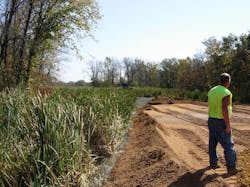For more than 100 years, residents of and visitors to southern Wisconsin have enjoyed the natural beauty of Lake Belle View, a 92-acre lake fed by the Sugar and West Branch Sugar rivers. The lake and its surrounding wetlands welcome swimmers, fishers, canoeists and birdwatchers while playing host to music festivals, picnics and sporting events.
Nearby farm and city runoff brought in by the two rivers, however, gradually stole the sparkle from this local jewel. Since 1926, 4 ft of river sediment had accumulated in the lake, reducing its mean depth to 2 ft. High bacteria levels barred swimmers. Nearby forest floods killed trees. Algae blooms caused by fertilizer and urban runoff created underwater dead zones that killed fish and damaged water quality.
Public-Private Partnership
An intensive citizen effort began in the early 1980s to restore the lake to its former self. After decades of planning and lobbying by local officials and lake supporters, authorities approved a restoration plan in October 2009. Ultimately, the $4-million project was funded by grants, private contributions and a local tax referendum that raised $1 million.
The goals of the project were to improve and increase:
- Water quality;
- Lake depth;
- Diversity of aquatic habitat;
- Diversity and quality of wetland habitat at the perimeter of the lake and beyond; and
- The natural beauty of
- the ecosystem.
To achieve these goals, engineers set out to refill the lake and separate it from the river system. This would be accomplished by constructing a 3,200-ft berm to decrease the rate of surface runoff from the rivers, reducing the amount of sediment that reaches Lake Belle View. In addition to controlling erosion, the berm would serve as a pedestrian walkway and bike path.
Building the Berm
The project engineer determined that building a berm atop the existing grade satisfied the project’s green growth initiative and was the simplest, most cost-effective solution.
Site conditions, however, presented a challenge. The berm subgrade consisted of saturated, silty lake sediments with very low shear strength. Removing these sediments would widen the footprint of the berm construction in the wetlands and affect the environment negatively. Furthermore, removal and replacement of the sediments would be costly.
General contractor Advance Construction, Green Bay, Wis., decided instead to construct a mechanically stabilized layer (MSL) using Tensar TriAx geogrid at the base of the berm.
“We chose Tensar’s TX160 geogrid because it reduced construction costs and improved the feasibility of the overall design by allowing us to build the berm on the existing grade, reducing our labor and equipment costs,” said Glenn Joski, president of Advance Construction.
The geogrid uses a triangular aperture to increase the in-plane stiffness of the MSL.
“It creates an MSL that, when combined with an aggregate layer, stabilizes soft soils,” said Jim Howley, P.E., senior regional manager for Tensar Intl. Corp. “The triangular design and rib profile of [the] geogrid forms the MSL by confining aggregate particles within its apertures to create mechanical interlock.”
Mechanical interlock increases the load-bearing capacity of the soil, providing 360 degrees of load distribution.
The MSL gave the contractor a stable construction platform for the remainder of the berm embankment. Construction began with one layer of geogrid, placed directly at the base of the berm to bridge the lake sediment across a 17,000-sq-yd area. Next, adjacent rolls of geogrid were overlapped by 3 ft and temporarily secured with nylon cable ties. Then, the geogrid layer was covered with approximately 24 in. of well-graded sand to create the MSL supporting the berm. Finally, select granular fill built up the berm to about 5 ft above grade.
In addition to the geogrid product, Tensar brought its nearly 30-year soil stabilization experience to the project by offering design and the specifications utilizing TX160. Company engineers helped determine the proper aggregate fill gradation for accurate stability and separation of the embankment fill, the requirements for geogrid placement, and the limitations for embankment construction and equipment.
“Using geogrid in a construction project such as the Lake Belle View project can reduce construction costs by as much as 50% because geogrid requires less aggregate, thus reducing labor and equipment,” Howley said. “Geogrid can also increase the lifespan of the surface and enhances the reliability of trafficked surfaces.”
Paradise Restored
Advance Construction reduced its labor and equipment costs on the Lake Belle View project because it did not have to over-excavate or haul in additional aggregate from off site. The use of the geogrid also kept the construction footprint to a minimum in this environmentally sensitive area.
This project is an example of how geogrid technology made the construction of the berm both possible, and economically and environmentally feasible, according to Joski.
“Ultimately, the geogrid improved the slope stability of the berm embankment, reduced both overall and differential settlement, and separated the lake sediments and the granular fill used to construct the berm.”
The Lake Belle View restoration was completed in Summer 2011, allowing local citizens to resume their long-delayed recreation at the lake and community park. Howley noted that it has become a renewed source of area pride.
“This restoration project has transformed the lake and park areas back into the community’s central meeting place—a venue for social and recreational gatherings and a catalyst for economic development.”
John Bolton is director of marketing for Tensar Corp. Bolton can be reached at [email protected] or 704.658.1165.
Download: Here


